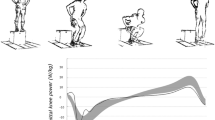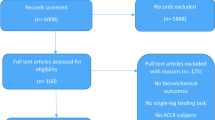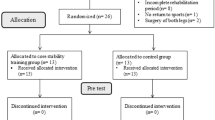Abstract
Purpose
Objective functional outcomes following isolated radial lateral meniscus tears in the athlete between the ages of 14–25 are not clearly defined. The objective of this study was to determine whether patients following lateral meniscectomy demonstrate lower extremity asymmetries relative to control athletes 3 months after surgery. We hypothesized that following lateral meniscectomy, athletes aged 14–25 years old would demonstrate altered landing biomechanics compared to sex, age, height, weight, and sport-matched controls.
Methods
A total of 18 subjects were included in this study. Nine patients (7 men and 2 women, 20.1 ± 2.8 years) who had undergone first-time isolated radial lateral meniscus tears were tested 3 months following partial lateral meniscectomies and compared to nine sex, age, height, weight, and sport-matched controls (7 men and 2 women, 19.7 ± 3.1 years). A ten-camera motion analysis system and two force platforms were used to collect three trials of bilateral drop landings. A 2X2 ANOVA was used to test the interaction between side (involved vs. uninvolved) and group (patient vs. control).
Results
The patient group landed with a decreased internal knee extensor moment compared to the uninvolved side and controls (interaction P < 0.05). The involved limb quadriceps isokinetic torque was not decreased compared to the contralateral or control (n.s.). Decreased knee extensor moments were significantly associated with reduced measures of function (IKDC scores: r = 0.69; P < 0.05).
Conclusions
Athletes who return to sport at approximately 3 months following a partial lateral meniscectomy may employ compensation strategies during landing as evidenced by reduced quadriceps recruitment and functional outcome scores. Clinicians should focus on improving quadriceps function during landing on the involved leg in an attempt to decrease residual limb asymmetries.
Level of evidence
Case–control study, Level III.


Similar content being viewed by others
References
Bandy WD, McLaughlin S (1993) Intramachine and intermachine reliability for selected dynamic muscle performance tests. J Orthop Sports Phys Ther 18:609–613
Baratz ME, Fu FH, Mengato R (1986) Meniscal tears: the effect of meniscectomy and of repair on intraarticular contact areas and stress in the human knee. A preliminary report. Am J Sports Med 14:270–275
Barber-Westin SD, Smith ST, Campbell T, Noyes FR (2010) The drop-jump video screening test: retention of improvement in neuromuscular control in female volleyball players. J Strength Cond Res 24:3055–3062
Benjaminse A, Otten E (2010) Acl injury prevention, more effective with a different way of motor learning? Knee Surg Sports Traumatol Arthrosc. doi:10.1007/s00167-010-1313-z
Bobbert MF, Huijing PA, van Ingen Schenau GJ (1987) Drop jumping. I. The influence of jumping technique on the biomechanics of jumping. Med Sci Sports Exerc 19:332–338
Bonneux I, Vandekerckhove B (2002) Arthroscopic partial lateral meniscectomy long-term results in athletes. Acta Orthop Belg 68:356–361
Chatain F, Adeleine P, Chambat P, Neyret P (2003) A comparative study of medial versus lateral arthroscopic partial meniscectomy on stable knees: 10-year minimum follow-up. Arthroscopy 19:842–849
DeVita P, Skelly WA (1992) Effect of landing stiffness on joint kinetics and energetics in the lower extremity. Med Sci Sports Exerc 24:108–115
Durand A, Richards CL, Malouin F, Bravo G (1993) Motor recovery after arthroscopic partial meniscectomy. Analyses of gait and the ascent and descent of stairs. J Bone Joint Surg Am 75:202–214
Fitzgibbons RE, Shelbourne KD (1995) “Aggressive” nontreatment of lateral meniscal tears seen during anterior cruciate ligament reconstruction. Am J Sports Med 23:156–159
Ford KR, Myer GD, Hewett TE (2003) Valgus knee motion during landing in high school female and male basketball players. Med Sci Sports Exerc 35:1745–1750
Ford KR, Myer GD, Hewett TE (2007) Reliability of landing 3d motion analysis: implications for longitudinal analyses. Med Sci Sports Exerc 39:2021–2028
Ford KR, Myer GD, Melson PG, Darnell SC, Brunner HI, Hewett TE (2009) Land-jump performance in patients with juvenile idiopathic arthritis (jia): a comparison to matched controls. Int J Rheumatol. doi:10.1155/2009/478526:478526
Hewett TE, Ford KR, Myer GD (2006) Anterior cruciate ligament injuries in female athletes: part 2, a meta-analysis of neuromuscular interventions aimed at injury prevention. Am J Sports Med 34:490–498
Hewett TE, Stroupe AL, Nance TA, Noyes FR (1996) Plyometric training in female athletes. Decreased impact forces and increased hamstring torques. Am J Sports Med 24:765–773
Irrgang JJ, Anderson AF, Boland AL, Harner CD, Kurosaka M, Neyret P, Richmond JC, Shelborne KD (2001) Development and validation of the international knee documentation committee subjective knee form. Am J Sports Med 29:600–613
Irrgang JJ, Snyder-Mackler L, Wainner RS, Fu FH, Harner CD (1998) Development of a patient-reported measure of function of the knee. J Bone Joint Surg Am 80:1132–1145
Levy IM, Torzilli PA, Gould JD, Warren RF (1989) The effect of lateral meniscectomy on motion of the knee. J Bone Joint Surg Am 71:401–406
Minning SJ, Myer GD, Mangine RE, Eifert-Mangine M, Colosimo AJ (2008) Serial assessments to determine normalization of gait following anterior cruciate ligament reconstruction. Scand J Med Sci Sports 19:569–575
Musahl V, Citak M, O’Loughlin PF, Choi D, Bedi A, Pearle AD (2010) The effect of medial versus lateral meniscectomy on the stability of the anterior cruciate ligament-deficient knee. Am J Sports Med 38:1591–1597
Myer GD, Ford KR, Palumbo JP, Hewett TE (2005) Neuromuscular training improves performance and lower-extremity biomechanics in female athletes. J Strength Cond Res 19:51–60
Myer GD, Paterno MV, Ford KR, Hewett TE (2008) Neuromuscular training techniques to target deficits before return to sport after anterior cruciate ligament reconstruction. J Strength Cond Res 22:987–1014
Noehren B, Scholz J, Davis I (2010) The effect of real-time gait retraining on hip kinematics, pain and function in subjects with patellofemoral pain syndrome. Br J Sports Med. doi:10.1136/bjsm.2009.069112
Orishimo KF, Kremenic IJ, Mullaney MJ, McHugh MP, Nicholas SJ (2010) Adaptations in single-leg hop biomechanics following anterior cruciate ligament reconstruction. Knee Surg Sports Traumatol Arthrosc 18:1587–1593
Papalia R, Del Buono A, Osti L, Denaro V, Maffulli N (2011) Meniscectomy as a risk factor for knee osteoarthritis: a systematic review. Br Med Bull. doi:10.1093/bmb/ldq043
Pena E, Calvo B, Martinez MA, Palanca D, Doblare M (2006) Why lateral meniscectomy is more dangerous than medial meniscectomy. A finite element study. J Orthop Res 24:1001–1010
Petrosini AV, Sherman OH (1996) A historical perspective on meniscal repair. Clin Sports Med 15:445–453
Rangger C, Klestil T, Gloetzer W, Kemmler G, Benedetto KP (1995) Osteoarthritis after arthroscopic partial meniscectomy. Am J Sports Med 23:240–244
Roos EM, Ostenberg A, Roos H, Ekdahl C, Lohmander LS (2001) Long-term outcome of meniscectomy: symptoms, function, and performance tests in patients with or without radiographic osteoarthritis compared to matched controls. Osteoarthr Cartil 9:316–324
Seon JK, Gadikota HR, Kozanek M, Oh LS, Gill TJ, Li G (2009) The effect of anterior cruciate ligament reconstruction on kinematics of the knee with combined anterior cruciate ligament injury and subtotal medial meniscectomy: an in vitro robotic investigation. Arthroscopy 25:123–130
Servien E, Acquitter Y, Hulet C, Seil R (2009) Lateral meniscus lesions on stable knee: a prospective multicenter study. Orthop Traumatol Surg Res 95:S60–S64
Sturnieks DL, Besier TF, Hamer PW, Ackland TR, Mills PM, Stachowiak GW, Podsiadlo P, Lloyd DG (2008) Knee strength and knee adduction moments following arthroscopic partial meniscectomy. Med Sci Sports Exerc 40:991–997
Sturnieks DL, Besier TF, Mills PM, Ackland TR, Maguire KF, Stachowiak GW, Podsiadlo P, Lloyd DG (2008) Knee joint biomechanics following arthroscopic partial meniscectomy. J Orthop Res 26:1075–1080
Acknowledgments
The authors would like to acknowledge funding support from The University Orthopaedic Research and Education Foundation, University of Cincinnati department of Orthopaedic Surgery and National Institutes of Health/NIAMS Grants R01-AR049735, R01-AR05563 and R01-AR056259.
Author information
Authors and Affiliations
Corresponding author
Rights and permissions
About this article
Cite this article
Ford, K.R., Minning, S.J., Myer, G.D. et al. Landing adaptations following isolated lateral meniscectomy in athletes. Knee Surg Sports Traumatol Arthrosc 19, 1716–1721 (2011). https://doi.org/10.1007/s00167-011-1490-4
Received:
Accepted:
Published:
Issue Date:
DOI: https://doi.org/10.1007/s00167-011-1490-4




